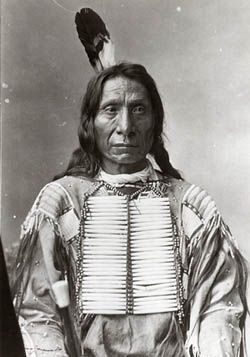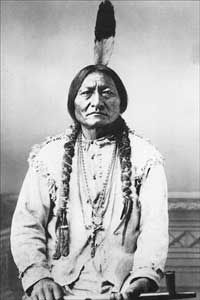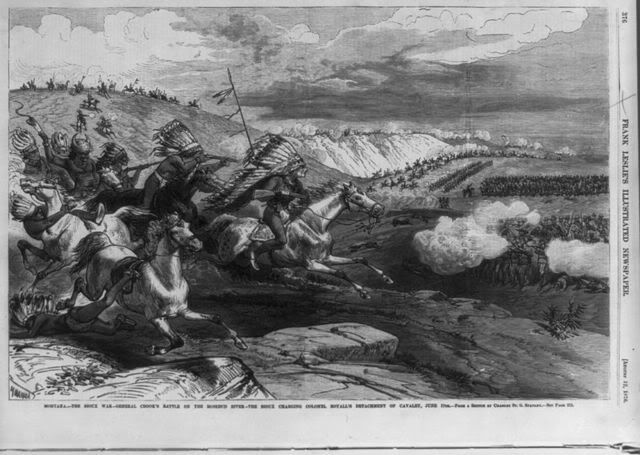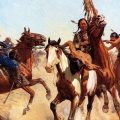In 1851, the United States called a treaty council at Fort Laramie, Wyoming which was attended by 8,000 – 12,000 Indians from the Cheyenne, Arapaho, Shoshone, Crow, Assiniboine, Arikara, Gros Ventre, Mandan, and Hidatsa tribes. The purpose of the council and of the resulting treaty was to establish peace between the United States and the tribes, including a promise to protect Indians from European-Americans, and to stop the tribes from making war with one another. At the Fort Laramie Treaty Council, each tribal area was defined.
The Council ignored the participation of the Shoshone and assigned their northeastern hunting range to the Crow. As there were no River Crow at the Council, the Mountain Crow version of their geographic rights and hunting areas was used and was assumed by the Americans to be binding to all of the Crow tribes.
The Sioux received the rights to the Black Hills and other lands claimed by the Northern Cheyenne.
Signing the treaty for the Yankton Sioux was Smutty Bear who complained about the destruction of grass and trees by travelers on the Overland Trail and about the subsequent scarcity of game. Smutty Bear’s complaint turned out to be prophetic. Over the next decade more tribes were pushed out onto the Plains where they were supposed to depend on the buffalo for subsistence. At the same time the buffalo herds decreased due to a combination of over-hunting, destruction of grazing by cattle herds and immigrant wagon trains, and the destruction of the environment by the railroads. Consequently, the Sioux had to hunt in lands farther west. The tyranny of the map laid down by the Americans during the Treaty of Fort Laramie was soon obsolete and did not reflect the new reality of the need to find food and clothing.
The United States has always maintained a working policy of transferring potential wealth-minerals, petroleum, timber, good farmlands-from Indians to non-Indians. Thus in 1862, when gold was discovered on Grasshopper Creek in Montana, all treaty agreements about keeping non-Indians out of Indian territory were ignored. Soon the miners were invading Indian territories with the support of the United States government. The gold discovery resulted in heavy traffic along the Montana Trail between Salt Lake City and the gold fields. The Trail passed through Shoshone territory in Utah and Idaho. On the one hand, the Indians resented the new intrusion, but they were also intrigued by the possibilities for plunder of the relatively small and unprotected miners’ parties.
In 1863, American miners and others seeking a faster way to the Montana gold fields created the Bozeman trail. The trail started from the Oregon Trail near present-day Douglas, Wyoming and ran north into Montana. While livestock grazing and water were scarce along this route, it was the fastest way to the gold fields. The Americans were unconcerned that it cut through the buffalo hunting grounds of the Lakota, Arapaho, and Northern Cheyenne. The Indians, however, found this illegal incursion into their prime hunting grounds to be intolerable. In response they began a series of sporadic raids against the American emigrants.
In 1865, the gold fields of Virginia City, Montana were connected with points east through the Niobrara-Virginia City Wagon Road. The road cut through the hunting grounds of the Sioux, Cheyenne, and other tribes.
That same year, the Sawyers Expedition-a civilian road-building group with military escort-entered the Powder River country in Wyoming. The group of 143 men, including 118 cavalry, reached Pumpkin Buttes near present-day Wright without any Indian opposition. Here they were attacked by a war party of 600 Southern Cheyenne, Northern Cheyenne, and Sioux warriors.
After several hours of fighting, the Indians called for a truce. Dull Knife, Bull Bear, Red Cloud, and Charlie Bent met with the Americans and George Bent acted as interpreter. The Cheyenne explained to the Americans that peace would be possible on only one condition: the hanging of Colonel Chivington, the American leader in the Sand Creek massacre. The Cheyenne felt that they were strong enough to fight the U.S. troops.
Over the objections of the military officer, the civilian leader of the expedition offered the Indians bacon, sugar, coffee, flour, and tobacco in exchange for safe passage. The peace was short-lived as two troops were killed when they wandered out among the Indians.
The 12th Missouri Cavalry and the 2nd Missouri Light Artillery then entered the Powder River Country from Nebraska to wage war against the Sioux, Cheyenne, and Arapaho. The cavalry was armed with Spencer repeating carbines which had an effective range of 900 yards. Camped in the area, but unknown to the army, were 1,000 Sioux and Cheyenne lodges with 6,000 people.
After several encounters with Indian war parties in which the army had the advantage of superior fire power, the army decided to turn back and head for Fort Laramie. For several days a running battle was fought with Cheyenne warriors armed with bows, lances, and a few trade guns. Roman Nose, riding a white war horse, rode in front of the troops, demonstrating his bravery and prowess. While his horse was hit, Roman Nose escaped injury and the fight became known as “Roman Nose’s Fight.”

Roman Nose is shown above.
In 1865, an army force of 558 soldiers and 179 Indians (95 Pawnee and 84 Winnebago and Omaha) set out to attack the Cheyenne, Sioux, and Arapaho in the Powder River area where the Indians were holding their traditional summer ceremonies.
The army encountered an Arapaho village under the leadership of Black Bear and Medicine Man. By the time the army reached the village most of the warriors were mounted on their horses and the women and children had already begun their march to a new camp. For an hour, the army howitzers pounded the village and the Indian scouts killed Arapaho men, women, and children indiscriminately. As the soldiers entered the village to engage in fierce hand-to-hand fighting, the Arapaho women fought beside the men. Many of the Arapaho reached a high point near the village. The army destroyed the Arapaho village and their supplies. Eight Arapaho women and 13 children were captured; 65 Arapaho were killed; 250 lodges burned; and 500 horses captured.
In 1866, Sioux leader Red Cloud and others met with U.S. officials at Fort Laramie to discuss the Bozeman Trail. General Sherman provided the Indians with goodwill gifts of gunpowder, lead, and food. The Government asked permission for emigrants to cross Sioux and Cheyenne lands. In addition, General Sheridan sought permission for three forts to be built on the Bozeman Trail connecting the Platte River with Montana’s mines. Red Cloud broke off negotiations because the United States had brought in soldiers to use as a threat of force. In the months that followed, the Oglala and other Sioux tribes engaged in guerrilla war along the Bozeman Trail, making it dangerous to travel.

Red Cloud is shown above.
The army, under orders to protect the gold seekers, established Fort Reno, Fort Phil Kearny, and Fort C.F. Smith along the Bozeman Trail. The army was determined to make the Bozeman Trail a major thoroughfare to the Montana gold fields. The United States government was reeling under the immense financial strain of the Civil War and saw the Montana gold fields as one answer to the financial problems.
In one battle near Fort Phil Kearny in Wyoming, Captain William J. Fetterman and 80 soldiers were killed by Oglala and Cheyenne warriors. The Cheyenne were under the leadership of Little Horse, a contrary. The soldiers in the fort prepared to blow it up if the Indians broke through their defenses and the message from the fort was
“We are fighting a foe that is the devil.”
Montana Territorial Governor Thomas Meagher wrote in 1866:
“As for the Sioux, and their allies and accomplices, it is my clear and positive conviction that they will never be reduced to friendly and reliable relations with the whites but by the strong and crushing hand of the military power of the nation.”
In Montana, Oglala leader Red Cloud visited the Crow, bringing them gifts of tobacco, horses, and ammunition. The Oglala asked the Crow to join them in their fight against the Americans. The Crow, who had long been Oglala enemies, declined to join them.
A war party of 3,000 Cheyenne, Sioux, and Arapaho warriors was formed to attack the army station on the Platte River Bridge, near present-day Casper, Wyoming. The army station was protected by a wooden stockade and a company of soldiers.
The Cheyenne warriors were led by Dull Knife, White Bull, and Roman Nose. The Sioux warriors were led by Old Man Afraid of His Horses, Young Man Afraid of His Horses, and Red Cloud. A small group of warriors acted as decoys and a detachment of soldiers was sent out to drive them off. Before the ambush trap could be closed, however, the soldiers were ordered back and returned without loss.
The following morning 25 soldiers were sent out to escort a military wagon train back to the fort. They were attacked and four soldiers killed. The war party then attacked the wagon train, killing over 20 soldiers. At least seven Cheyenne were killed.
From the Indian perspective, these limited attacks were worthwhile as individual warriors accomplished heroic deeds. The war party had attained sufficient glory for one day and the warriors returned home without attacking the army station.
In 1867, the Sioux and Cheyenne continued their battles against the building of the Bozeman Trail. Dull Knife and Two Moon led the Cheyenne against soldiers near Fort C. F. Smith. Red Cloud attacked woodcutters near Fort Phil Kearny. In Montana, a war party of 700 Sioux warriors attacked a group of 19 soldiers and six civilians who were working in a hayfield. The Americans had the advantage of newer and better guns-rapid-firing, breech-loading 50 caliber Springfield rifles and repeating rifles. After several hours of battle, the Sioux withdrew.
In 1867, the Northern Arapaho under the leadership of Medicine Man met with the Americans at Fort Fetterman in an attempt to reestablish peaceful relations. Medicine Man told the Americans that they did not want to be involved in the Sioux and Cheyenne raids, nor did they want to go to the Sioux Reservation or to Indian Territory. He told them that the Arapaho wanted to stay in the north, in Montana and Wyoming.
The war over the Bozeman Trail, also known as Red Cloud’s War, officially ended in 1868 with the Treaty of Fort Laramie which established the Great Sioux Reservation and preserved the Powder River and Big Horn country as un-ceded Indian territory. The reservation, according to article 2, was
“set apart for the absolute and undisturbed use and occupation of the Indians”.
No cession of the reservation would be valid without the signatures of three-fourths of the adult males.
The treaty was signed with 10 Sioux tribes – Brulé, Oglala, Miniconjou, Yanktonai, Hunkpapa, Blackfeet, Cuthead, Two Kettle, Sans Arcs, Santee- and with the Arapaho.
The Indians were promised that they could continue to use their hunting grounds outside of the reservation for “so long as the buffalo may range thereon in such numbers as to justify the chase.” The American government, however, was confident that the buffalo would soon be exterminated and thus the Sioux would be confined to the reservation.
The Indians promised that they would withdraw all opposition to the construction of railroads; that they would not attack the people of the United States; that they would not capture white women or children; that they would not kill or scalp white men.
From a Sioux perspective, the treaty was a success as it forced the abandonment of the Bozeman Trail through their hunting grounds and the three forts that guarded the trail.
The Arapaho felt that they had little choice but to sign the treaty. They agreed to settle on a reservation within one year: either with the Sioux or with the Cheyenne and Southern Arapaho in Oklahoma or with the Crow in Montana. Signing the treaty for the Arapaho were Black Bear, Medicine Man, Little Wolf, Littleshield, and Sorrel Horse.
Following the treaty council the army abandoned all of its forts except for Fort Fetterman in Wyoming. The Sioux burned all of the abandoned forts. The burning of the forts was a symbol of their victory against the American invasion of their country.




Leave a Reply